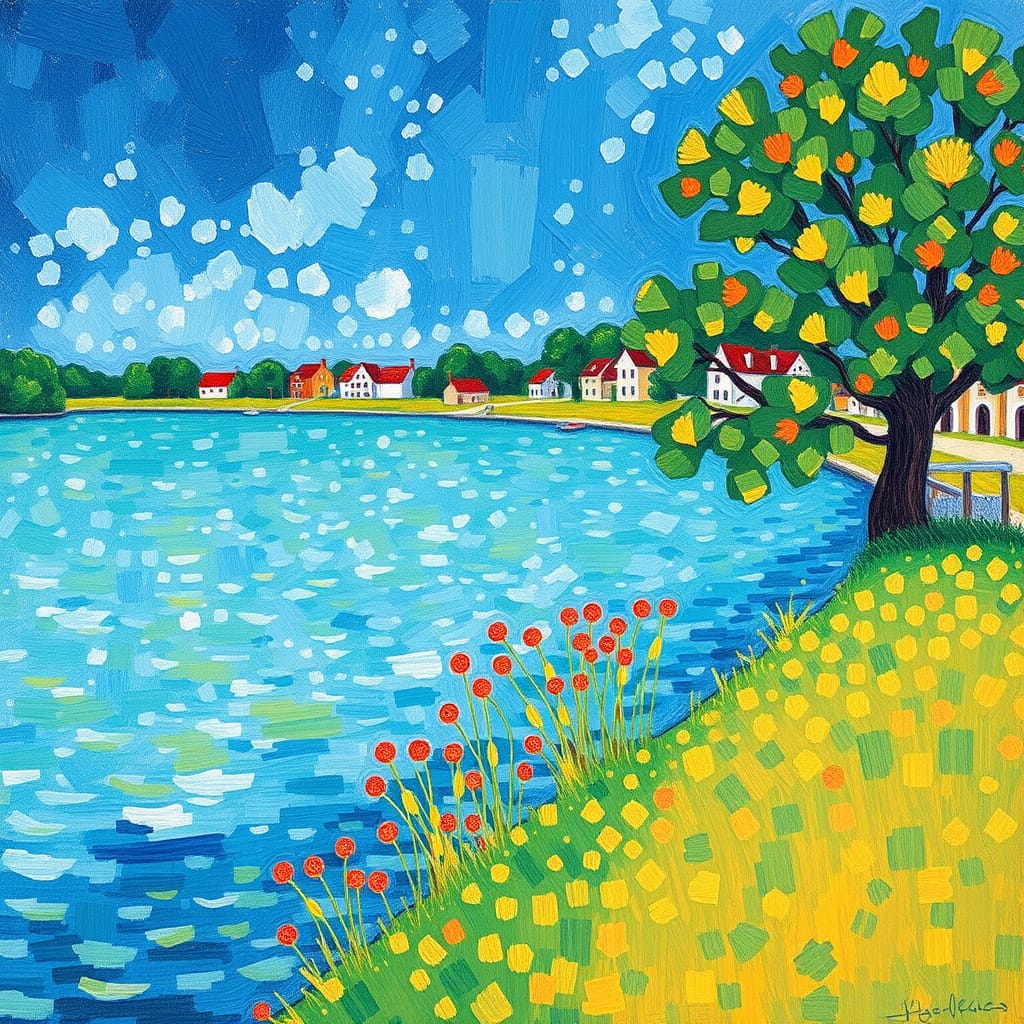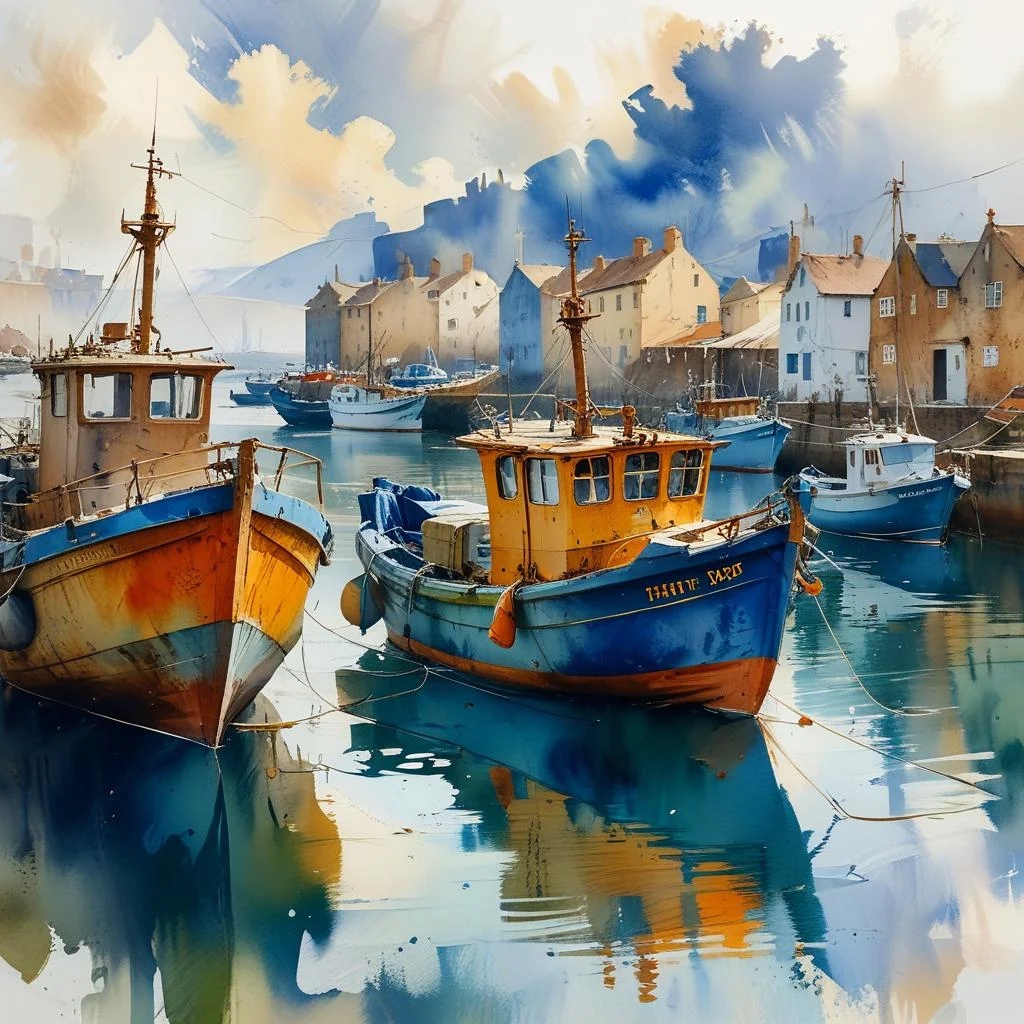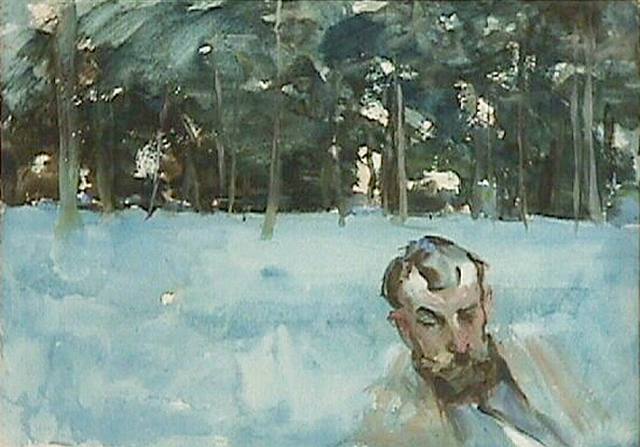Georges Seurat, a pioneering figure in the world of art, is renowned for his innovative techniques and profound influence on modern painting.
Key Summary
- Georges Seurat: French Neo-Impressionist artist who pioneered Pointillism, a technique using tiny dots of pure color to create optical blending.
- Key Work: “A Sunday Afternoon on the Island of La Grande Jatte”—his iconic masterpiece showcasing meticulous Pointillist methods.
- Legacy: Inspired movements like Fauvism and Cubism, leaving a lasting impact despite his early death at 31.
Born on December 2, 1859, in Paris, Seurat’s contributions to the art world, particularly through the development of Pointillism and Neo-Impressionism, have left an indelible mark on the history of art. This article delves into the life, works, and enduring legacy of Georges Seurat, offering a unique perspective on his artistic journey and the impact of his groundbreaking methods. Commenting on Georges Seurat Pointillism:
“Seurat made a habit of concealing his working methods from other artists, even his assistants. He would begin a picture with a series of drawings and oil sketches but would keep the final composition a secret until it was finished.” – John Russell
Early Life and Education
Georges Seurat was born into a wealthy family in Paris. His father, Antoine Chrysostome Seurat, was a property owner, and his mother, Ernestine Faivre, was a Parisienne. Seurat had an older brother, Émile Augustin, and an older sister, Marie-Berthe. His early life was marked by a comfortable upbringing, which allowed him to pursue his artistic inclinations from a young age.
Seurat’s formal artistic education began at the École Municipale de Sculpture et Dessin, where he studied under the sculptor Justin Lequien. He later attended the École des Beaux-Arts in Paris, where he was taught by Henri Lehmann, a disciple of J.-A.-D. Ingres. During his time at the École des Beaux-Arts, Seurat developed a strong interest in the intellectual and scientific bases of art, which would later influence his unique painting techniques.
Development of Pointillism
Seurat’s most significant contribution to the art world is the development of Pointillism, a technique that involves the use of tiny, distinct dots of color that blend optically in the viewer’s eye. This method creates a shimmering effect and a sense of luminosity that is unique to Seurat’s works. The technique was inspired by contemporary optical theories and color relationships, which Seurat studied extensively.
What is Pointillism? Pointillism is characterized by the application of small, distinct dots of color that are applied in patterns to form an image. The technique relies on the ability of the eye and mind of the viewer to blend the color spots into a fuller range of tones. Seurat’s innovative use of this technique set him apart from his contemporaries and established him as a leading figure in the Neo-Impressionist movement.
Notable Works
A Sunday Afternoon on the Island of La Grande Jatte
One of Seurat’s most famous works is “A Sunday Afternoon on the Island of La Grande Jatte” (1884–1886). This large-scale painting is a masterclass in Pointillism, showcasing Seurat’s meticulous application of tiny dots of color to create a vibrant and luminous scene. The painting depicts people from various social classes relaxing in a park on an island in the Seine River, capturing a moment of leisure and tranquility.
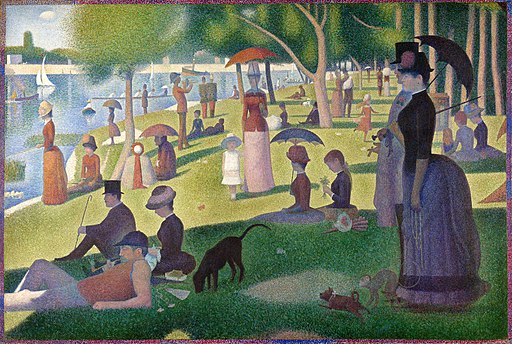
“A Sunday Afternoon on the Island of La Grande Jatte” is not only a technical marvel but also a cultural commentary. The painting’s subjects, their interactions, and the setting itself provide a snapshot of late 19th-century French society. The work’s monumental size and intricate detail make it a standout piece in Seurat’s oeuvre and a cornerstone of the Neo-Impressionist movement.
Bathers at Asnières
Another significant work by Seurat is “Bathers at Asnières” (1883–1884). This painting showcases young men relaxing by the Seine River and is notable for its smooth, simplified textures and carefully outlined figures. “Bathers at Asnières” reflects Seurat’s neoclassical training and his departure from the spontaneity of Impressionism. The work is a transitional piece, bridging the gap between traditional painting techniques and Seurat’s innovative Pointillist style.
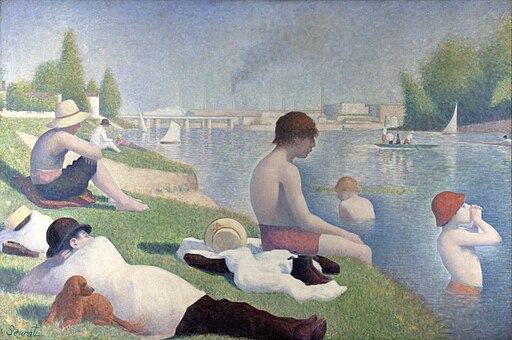
Personal Life and Legacy
Seurat’s personal life was marked by a secret relationship with Madeleine Knobloch, an artist’s model with whom he had a son, Pierre-Georges. Despite his fame and influence in the art world, Seurat kept his personal life private, concealing his relationship with Madeleine even from his closest friends. Tragically, Seurat died at the age of 31 on March 29, 1891, possibly from meningitis or another infectious disease. His son died two weeks later from the same illness.
Seurat’s legacy extends far beyond his lifetime. His innovative techniques and structured approach to painting had a profound influence on modern art, inspiring other artists and contributing to the development of Neo-Impressionism. Seurat’s work continues to be studied and admired by artists and art enthusiasts alike, serving as a testament to his enduring impact on the art world.
Seurat’s Scientific Approach to Art
What sets Seurat apart from his contemporaries is his scientific approach to art. Seurat was deeply influenced by the works of scientists and theorists such as Michel Eugène Chevreul, Ogden Rood, and David Sutter. He studied their theories on color, optics, and the emotional properties of lines and colors, incorporating these scientific principles into his painting techniques.
Seurat’s methodical approach to art is evident in his meticulous preparation for his paintings. He often created numerous sketches and oil studies before beginning a canvas, ensuring that each element of his composition was carefully considered. This disciplined approach allowed Seurat to achieve a level of precision and control over his work that was unprecedented in his time.
Top 10 Paintings by Georges Seurat
| Title | Description | Gallery |
|---|---|---|
| A Sunday Afternoon on the Island of La Grande Jatte | A large-scale painting showcasing Seurat’s Pointillist technique, depicting people relaxing in a park. | Art Institute of Chicago |
| Bathers at Asnières | A transitional work featuring young men relaxing by the Seine River, reflecting Seurat’s neoclassical training. | National Gallery, London |
| The Circus | An unfinished work that showcases Seurat’s Pointillist technique and his interest in capturing movement and energy. | Musée d’Orsay, Paris |
| The Channel of Gravelines, Petit Fort Philippe | A seascape painting that demonstrates Seurat’s use of color and light to create a sense of depth and atmosphere. | Private Collection |
| The Eiffel Tower | A painting that captures the iconic Eiffel Tower using Seurat’s distinctive Pointillist style. | California Palace of the Legion of Honor, San Francisco |
| Le Chahut | A vibrant painting that depicts a lively dance hall scene, showcasing Seurat’s use of color and movement. | Kröller-Müller Museum, Otterlo |
| Models (Les Poseuses) | A painting that features three female models in a studio setting, highlighting Seurat’s use of color and form. | Barnes Foundation, Philadelphia |
| Gray Weather, Grande Jatte | A landscape painting that captures the moody atmosphere of a gray day on the Grande Jatte. | Philadelphia Museum of Art |
| The Seine and la Grande Jatte – Springtime | A serene landscape painting that showcases Seurat’s use of color and light to create a sense of tranquility. | Royal Museums of Fine Arts of Belgium |
| Young Woman Powdering Herself | An intimate portrait of a woman applying powder, showcasing Seurat’s use of color and form. | Courtauld Institute of Art, London |
Thw Wrap: Georges Seurat Pointillism
Georges Seurat’s contributions to the art world are immeasurable. His development of Pointillism and Neo-Impressionism, along with his scientific approach to art, have left an indelible mark on the history of painting. Seurat’s works, such as “A Sunday Afternoon on the Island of La Grande Jatte” and “Bathers at Asnières,” continue to captivate audiences with their vibrant colors, intricate details, and cultural commentary.
Georges Seurat Pointillism: His legacy serves as a reminder of the power of innovation and the importance of blending art and science. His unique perspective on painting continues to inspire artists and art enthusiasts alike, ensuring that his impact on the art world will be felt for generations to come.

